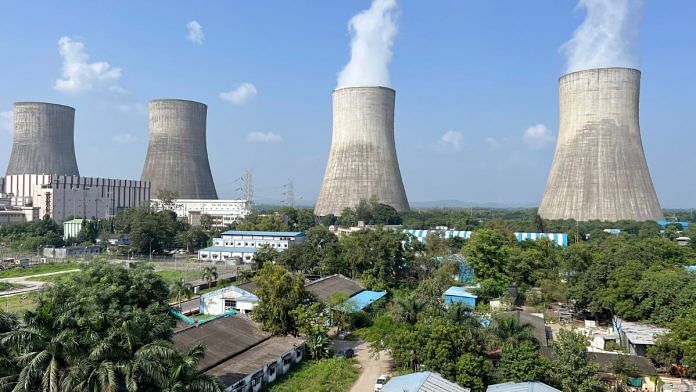New Delhi: One of India’s largest indigenously built nuclear power plants, the Kakrapar Atomic Power Station (KAPS) in Gujarat, achieved a key milestone Sunday as it reached its first criticality — the beginning of the regulated fission reaction — paving the way for its eventual transition to generating power for commercial use.
The fourth unit of the KAPS reached first criticality at 1.17 am in the presence of Nuclear Power Corporation of India Limited (NPCIL) Chairman-cum-Managing Director B. C. Pathak, NPCIL announced in a statement Sunday.
Unit-3 and Unit-4 of the KAPS are the first 700 megawatts Pressurised Heavy Water Reactors (PHWR) built by India. Unit-3 has been operating at full capacity since August. These reactors will boost India’s nuclear energy capacity, which is projected to reach 22,480 MW by 2031.
The first criticality — which is the start of a controlled fission chain reaction — is when a neutron (a particle with no electric charge) hits an atom like Uranium-235, and splits it into smaller atoms. This process is called nuclear fission, and it releases a lot of heat that can be converted into energy. Uranium is a good choice for nuclear power because it is easy to split (fissile).
To use this heat to generate electricity in nuclear power plants, the fission reaction has to be regulated and continuous, meaning that one fission leads to another in a chain-like manner. This is what KAPS-4 achieved. After the fission, the heat is used to make steam that turns a turbine and produces electricity.
The criticality test was approved by India’s nuclear regulator, Atomic Energy Regulatory Board (AERB), on 15 December for KAPS-4.
“After the first criticality, several other experiments will be conducted and power level raised in steps in the plant,” said the NPCIL statement.
Also Read: Pakistan’s new ISPR chief is son of Osama-linked scientist who said djinns can make electricity
What is special about the Kakrapar reactors
Currently, India has 23 nuclear power reactors in operation under NPCIL, with a total capacity of 7,480 MW. NPCIL is constructing nine more reactors, including KAPS Unit-4, with a total capacity of 7,500 MW.
Existing KAPS reactors Unit-1 and Unit-2 have a capacity of 220 MW each. But the new 700MW projects, Unit-3 and Unit-4, are “among the safest reactors in the world,” according to the NPCIL.
The Unit-3 and 4 reactors have steel-lined inner containment systems that prevent any radioactive material from escaping in case of an accident.
They also have passive decay heat removal systems, which safely cool down the reactor even when it is shut down. These features are inspired by the lessons learned from the Fukushima Daiichi nuclear disaster of 2011 in Japan when an earthquake caused a flood that damaged the power plant.
When Unit-3 reached first criticality in 2020, Prime Minister Narendra Modi praised it on Twitter (now ‘X’) as a success for Make in India.
Congratulations to our nuclear scientists for achieving criticality of Kakrapar Atomic Power Plant-3! This indigenously designed 700 MWe KAPP-3 reactor is a shining example of Make in India. And a trailblazer for many such future achievements!
— Narendra Modi (@narendramodi) July 22, 2020
NPCIL had also said that the Kakrapar reactors are designed by Indian scientists, and their equipment by Indian manufacturers.
India’s nuclear journey
Nuclear energy is a renewable energy source that does not emit greenhouse gases, and India wants to increase its share to meet its climate goals. It aims to generate 50 percent of its total electricity from non-fossil fuel sources by 2030, based on its commitment at the United Nations Convention of Parties (COP26) in Glasgow in 2021.
As of 2023, India has a total generation capacity of 417 GW, out of which 43 percent is from renewable sources, according to the power ministry.
In May, the NPCIL announced that it would partner with the National Thermal Power Corporation Limited (NTPC) to build nuclear power plants in Madhya Pradesh and Rajasthan, enhancing the country’s nuclear production potential.
However, nuclear energy still has a small role in India’s total energy generation, despite its rapid growth. In 2022-23, nuclear energy formed around 2.8 percent of India’s total energy production, according to government data.
According to a reply given by Union Minister of State for Science and Technology Jitendra Singh in Lok Sabha last week, of the current 23 nuclear reactors in the country, four are under project mode, one is shut for techno-economic assessment, and another is operating at 90 percent capacity.
India has an ambitious plan to triple its nuclear energy production from 7,480 MW to 22,480 MW in less than a decade, Singh added.
(Edited by Richa Mishra)
Also Read: US & other nations will push for tripling nuclear power by 2050 during COP28. India must join in



